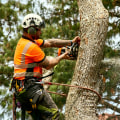Arborists are professionals in the practice of arboriculture, which is the cultivation, management and study of individual trees, shrubs, vines and other woody perennial plants. They can specialize in one or more disciplines such as diagnosis and treatment of pests, diseases and nutritional deficiencies in trees, climbing and pruning, protection from cables and lightning, or consulting and writing reports. In the UK, an arborist can earn qualifications up to a master's degree. Depending on the jurisdiction, there may be a number of legal issues surrounding the practices of arborists.
A botanist is a scientist who studies or experiments with plants. These plants can include a variety of organisms, including flowers, trees, and algae. The science of horticulture covers a broader spectrum than that of an arborist, whose concern is trees or shrubs. Arborists often offer tree removal, wiring or reinforcement services for structural support, transplanting and planting or shredding stumps when necessary.
Tree surgery is an important feature in the cultivation, management and study of trees, shrubs and other plants. Before starting work in the UK, arborists have a legal responsibility to inspect trees for wildlife, especially bats which are given particular legal protection. Homeowners' associations seeking to draft restrictive agreements or legislative bodies seeking to draft laws involving trees may seek advice from arborists to avoid future difficulties. An agronomist uses knowledge of how plants grow to improve agriculture while a food scientist discusses how to use plants as food products.
The protagonist of Italo Calvino's novel The Baron of Trees lives life on the ground as a child and spends the rest of his life swinging from tree to tree in the Italian countryside. Arborists generally focus on the health and safety of individual plants and trees rather than managing forests or harvesting timber (forestry or forestry). In addition, any tree in the UK can be covered by a tree conservation order and it is illegal to perform any work on a tree including felling or pruning before permission is sought from the local council. Some commonly offered services are considered unacceptable by modern arboricultural standards and can seriously damage, disfigure, weaken or even kill trees.
The work of an arborist may involve very large and complex trees or ecological communities and their abiotic components in the context of the landscape ecosystem. An example of this is the covering of trees, the cutting or placing of hats where the entire tops of the trees or the main stems are removed usually by transversely cutting the stem or the main stems or the leaders leaving large and unsightly pieces. In recent years research has shown that wound dressings such as paint tar or other coatings are unnecessary and can damage trees.



